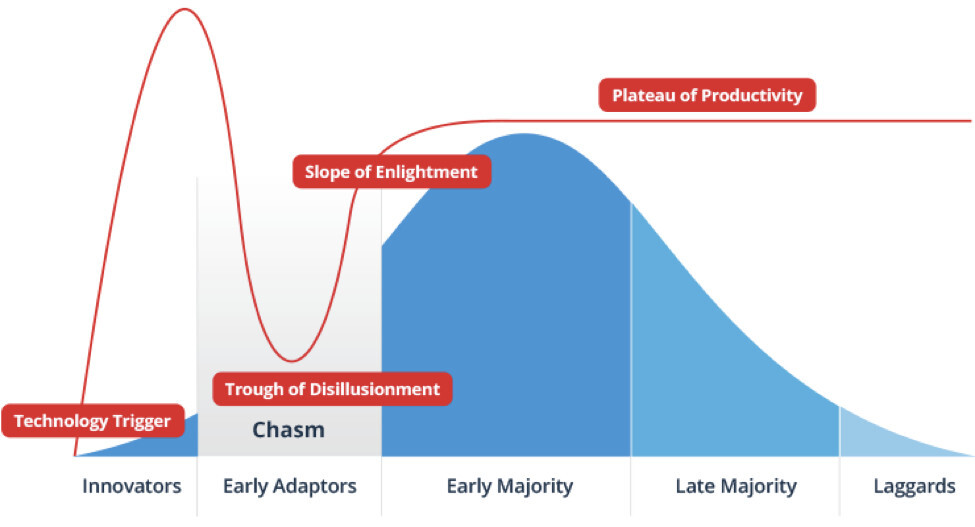
The Hype Cycle and the Chasm
To better understand the technology adoption lifecycle popularized by Geoffrey Moore's book "Crossing the Chasm," I've compared Gartner Research's Hype Cycle to it. Market expectations and technology adoption rates are combined in these two models, but people often misinterpret the timelines and implications. So if you’re involved in technology as an engineer, marketer, or manager, read on!
The Gartner Hype Cycles provide a pictorial representation of the maturity and acceptance of technologies and applications, as well as how they are potentially relevant to solving real business problems and seizing new opportunities.
How Do Hype Cycles Work?
The Hype Cycle has five key phases:
- Technology Trigger: A potential technology breakthrough kicks things off.
- Peak of Inflated Expectations: Early publicity produces a number of success stories.
- Trough of Disillusionment: Interest wanes as implementations fail to deliver.
- Slope of Enlightenment: More instances of benefits start to crystallize and be understood.
- Plateau of Productivity: Mainstream adoption starts to take off.
The Hype Cycle benefits:
- Distinguish the hype from the true drivers of a technology's commercial promise.
- Reduce the risk associated with your technology investment decisions.
- Contrast your knowledge of the business value of technology with the objectivity of seasoned IT analysts.
For 2021, The Hype Cycle for the emerging technologies looks like this:
For 2021, The Hype Cycle for AI looks like this:
Take note of how chatbots are progressing towards the slope of enlightenment, as many early adopters are embedding it into their business strategies and developing best practices.
Now, the knowledge of technological advances and trends makes more sense when you look at how technologies ‘cross the chasm’ – on how technologies become more mainstream and get to survive.
This is a critical challenge for all start-ups: how do they grow from niche to big, scaling up and gaining market share?
The following is an excellent theory about how you might go about doing this. And it's been fascinating to watch start-ups adjust their social media and marketing strategies as they approach the chasm.
When a startup has crossed 16% of the adoption, it should shift its marketing tactics from 'scarcity' to 'Social proof'
The idea is that when you combine these theories, you get some spectacular results.
Many people have made the mistake of attempting to tie the Gartner Hype Cycle to Moore's Technology Adoption Lifecycle. The problem is that many people simply superimpose the two charts on top of each other, not comprehending that the Gartner Hype Cycle is only valid at the beginning of the Technology Adoption Lifecycle. The Hype Cycle, in particular, monitors perceptions of technology to a point within the Early Majority phase of the lifetime, which contains the "chasm" that Geoffrey Moore so eloquently describes in his book.
Customers and consumers of technology on the left side of the chasm are change agents eager to get a leg up on the competition. Customers and users, on the other hand, want to boost productivity in their current activities. This shift of technology users and customers across the chasm is what accounts for the Gartner Hype Cycle's huge swings in expectations!





Energy Industry Analyst
5moAkshay Warikoo Your comments demonstrate one of the classic areas of confusion related to the technology adoption lifecycle. Technologies and innovations don't cross the chasm...it is the specific application or use case of the technology that crosses the chasm. For example, "AI" doesn't cross the chasm. Rather "AI for kidney surgery in the U.S." crosses the chasm. (The Gartner hype cycle adds to this confusion) A recent survey shows "crossing the chasm" is frequently misunderstood and therefore widely misused. The most common mistakes and areas of confusion are listed in this article: https://www.hightechstrategies.com/crossing-the-chasm-confusion/
Amazing contribution! Thank you for the insights!